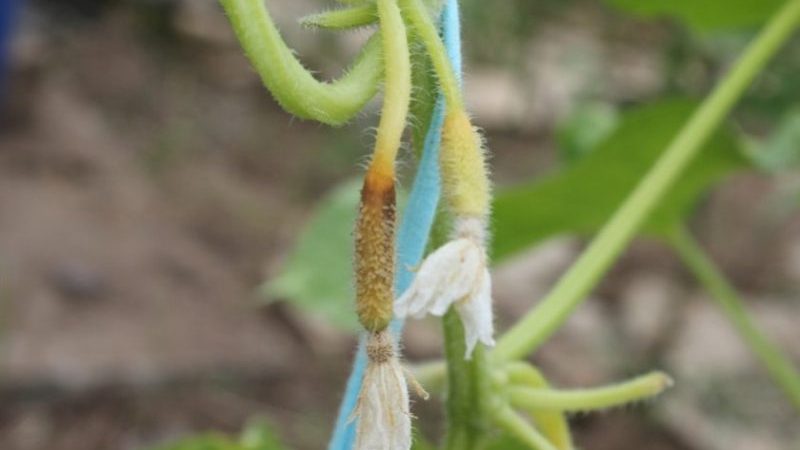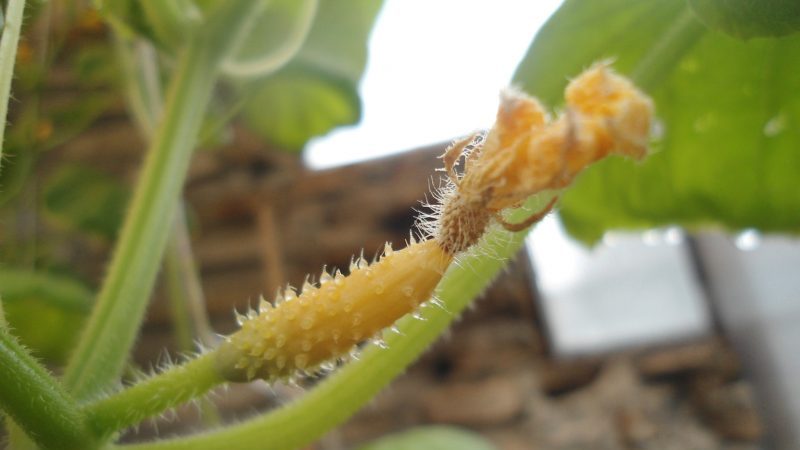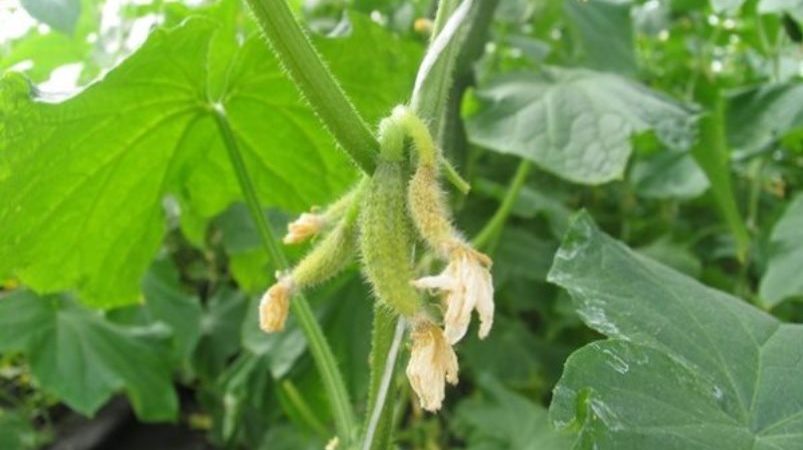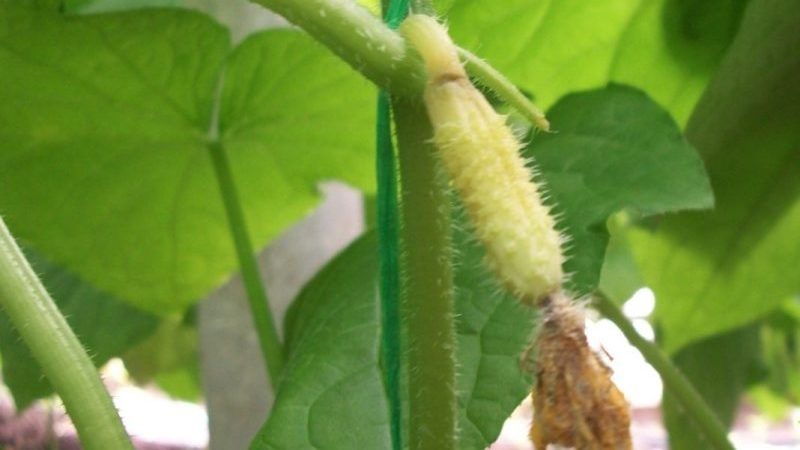Why do cucumber ovaries turn yellow and what to do to save the crop
If the ovaries of cucumbers turn yellow and fall off, this is an alarming signal for the gardener. You can not wait for the harvest if you do not help the plant in a timely manner. Experienced gardeners have their own secrets for dealing with this nuisance. Why cucumber ovaries turn yellow and how to prevent drying of bushes - we will tell in the article.
The content of the article
Why ovaries turn yellow, dry and fall off
Most often, growing problems arise from improper care. The ovary is capricious: it reacts sharply to errors, external factors. In addition, each variety has its own characteristics: a strictly defined planting density, pinching requirements, and pollination intensity.
Agrotechnical errors

One of the most common reasons for the wilting of an ovary is a violation of agrotechnical requirements. Inexperienced summer residents often plant bushes without forming. Many varieties build up a large vegetative mass, so they must be pinched. The procedure is carried out for all stepsons that appear from the axils of young 3-4 leaves, and then all the shoots that grow after the second leaf. This is necessary so that the sun-loving plant receives a sufficient amount of sunlight, and the ovary does not fall off.
Important! A thickened planting also belongs to gross agronomic violations. The optimal number of plants per 1 square meter is no more than 4, and when growing parthenocarpic plants (not requiring pollination) - only 2. Otherwise, the ovary will begin to wither and dry due to lack of lighting.
Ovaries on too young shrubs are also not a very favorable sign. An immature plant with undeveloped leaves may well give cucumbers, but without sufficient nutrition. Therefore, flowers on such weak plants are best removed.
External factors
Cucumbers are a very capricious and demanding crop. If you don't follow all the rules, it will be difficult to grow a good harvest. External factors can also negatively affect the development of the ovary:
- Wrong watering... Cucumbers are moisture-loving, but they need to be moistened in a special mode - 3 times a week before flowering and during fruiting, and in dry and hot weather - daily.
- Inappropriate air temperature is the most difficult factor to regulate outdoors. It is optimal for the full development of the ovaries to maintain 22–26 ° С during the day and at least 18 ° С at night.
- Rapid temperature fluctuations keep plants under stress.
- Overheating of the soil simply dries up the roots.
When growing vegetables in greenhouse conditions, it is necessary to regularly provide them with ventilation and an influx of fresh air. Otherwise, the ovaries can quickly turn yellow or are destroyed by diseases.
Diseases
Rapid drying and yellowing of the ovaries provoke various diseases. First of all, these are bacterioses affecting weakened or densely planted shrubs. The optimal environment for their development is temperature fluctuations.
Wilting is often observed due to root rot. The plant appears healthy but dries up from the top. Rot disrupts the supply of nutrients to all parts of the shrub.

Pests
In addition to agrotechnical ones, there are also biological reasons that provoke wilting of cucumber ovaries.
The most famous pests that attack young plants:
- spider mite;
- nematode;
- aphid;
- black flea;
- whitefly.
Insect activity peaks in mid-summer.Aphids, for example, winter in the root of the weed leaves, and in spring they actively spread throughout the site. It is impossible to notice a spider mite at once, its presence is indicated by the spider web entangling the plant. The pest quickly infects crops, sucking juice from them and preventing them from developing. As a result, the plant dries up and dies.
Important! The black flea beaver is considered the most dangerous pest; it is capable of completely destroying the area with cucumbers in a matter of days. Whitefly is no less dangerous: after its attack, the leaves and ovaries turn yellow, fruiting stops.
What to do to save the harvest

Before taking measures to save the harvest, it is necessary to find out the true cause of the wilting of the cucumbers. Experienced summer residents are advised to apply fertilizers first to eliminate nutritional shortages. Use the complex formulations "Diammofosk", "Ammofosk", "Potassium sulfate" and others.
Folk remedies are no less effective: 1 tbsp. l. urea, 3 tbsp. l. Dissolve wood ash in a bucket of water. Spray the cucumbers with the solution after sunset, so as not to cause burns on the foliage.
To save the harvest, they provide full pollination of flowers. When grown in greenhouses, this is done manually - pollen is transferred with a soft brush from male to female specimens. On the open ground, you need to attract bees, leaving containers with sweet water with sugar or honey on the site. You can also plant fennel, basil, chamomile, calendula nearby.
Reference. If there are too many stepchildren on the bushes, they will have to be removed. All lower shoots are removed up to the fifth leaf. Scourges that are actively stretching upward should be pinched and the plant will then sprout many lateral shoots with female flowers.
An obligatory stage of reanimation work is pest control. For insects, cucumbers are treated with the following compounds:
- infusion of onion peel;
- solution of ammonia (3 tbsp. l to dilute in a bucket of water);
- a solution of baking soda and laundry soap (1 tablespoon per 1 liter of water);
- chemical agents - "Commander", "Aktara", "Alatar" - are used exclusively before fruiting.
Biological preparations "Fitoverm", "Kleschevit", "Biotlin" are considered less dangerous and harmful.
Prevention measures
It is not difficult to grow cucumbers on your site, despite the exacting culture. To avoid possible problems, carry out preliminary work before planting. First of all, decide on the varieties: which are suitable for an open area, and which are recommended for greenhouses.
Reference. In greenhouses, it is better to plant self-pollinated hybrids, since there are much less natural pollinators in an enclosed space than in an open field.
It is important to consider the planting site - with sufficient lighting, well-fertilized soil and no drafts. Ideally, the landing site is changed every year. During periods of abnormal heat, it is advisable to equip a canopy over the plants, which will also save from heavy rain or hail. In wet weather, the drainage grooves will help to remove excess moisture.
Water the cucumbers only with water at room temperature, and ideally the same as the temperature of the soil.
Helpful advice from experienced farmers

Experienced summer residents are advised to protect the crop from a possible temperature drop at night. The bushes are covered with agrofiber or foil.
The root system of the plant grows 40 cm deep into the soil, so watering should be sufficient for moisture to penetrate to this depth. Otherwise, the roots will stretch to the soil surface and are more likely to suffer from the scorching sun or night cold.
One of the secrets of experienced farmers is the special preparation of the seeds. Experts recommend pre-hardening and heating the seed for better germination. Treatment with potassium permanganate will increase resistance to disease.
Read also:
Why do pumpkin ovaries turn yellow and fall off?
How and what to feed tomatoes during flowering and fruit setting.
What if the tomatoes in the greenhouse are blooming, but there is no ovary?
Conclusion
You can not wait for the harvest of cucumbers if you do not take measures in time to save the plant from yellowing of the ovaries. The methods directly depend on the reasons: non-compliance with the rules of agricultural technology, the development of diseases or pest attacks.
It is necessary to pay attention to summer cottage cultures constantly, and not from time to time. If you follow all the recommendations and preventive measures taken, you will not have to save the crop and dying ovaries.